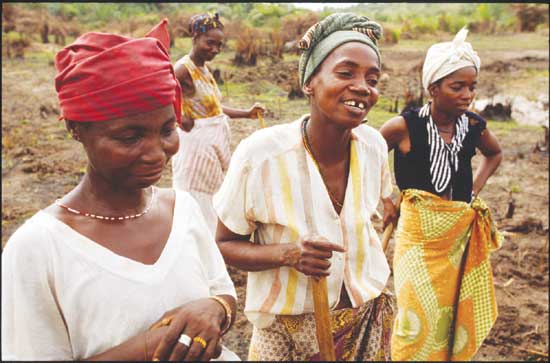By Olivier De Schutter, The New York Times, March 3, 2013
 |
| Women farmers are pillars of Africa's agriculture |
ACROSS the developing world, millions of people are migrating from
farms to cities in search of work. The migrants are mostly men. As a result,
women are increasingly on the front lines of the fight to sustain family farms.
But pervasive discrimination, gender stereotypes and women’s low social
standing have frustrated these women’s rise out of poverty and hunger.
Discrimination denies small-scale female farmers the same access men
have to fertilizer, seeds, credit, membership in cooperatives and unions, and
technical assistance. That deters potential productivity gains. But the biggest
barriers don’t even have to do with farming — and yet they have a huge impact
on food security.
As sole or principal caregivers, women and girls often face a heavy
burden of unremunerated household chores like cooking, cleaning, fetching
water, collecting firewood and caring for the very young and the elderly. These
uncompensated activities are equivalent to as much as 63 percent of gross
domestic product in India and Tanzania. But they result in lost opportunities
for women, who don’t have the time to attend classes, travel to markets to sell
produce or do other activities to improve their economic prospects.
To be sure, some female-headed farm households get remittances from
absent men, but that is often not enough to compensate for the economic
pressures they face. And we know that when women get more education and improve
their social and economic standing, household spending on nutrition increases,
child health outcomes improve and small farms become more productive.
A 2000 study of developing countries by the International Food
Policy Research Institute found that as much as 55 percent of the
reduction in hunger from 1970 to 1995 could be attributed to improvements in
women’s status in society. Progress in women’s education alone (which explained
43 percent of gains in food security) was nearly as significant as increased
food availability (26 percent) and health advances (19 percent) put together.
Many governments have recognized the causes of the poverty trap but
have not done enough to remove the obstacles facing women. For example, several
Asian countries have introduced stipends to keep girls in school, but many
schools lack adequate sanitation facilities; there is a paucity of female
teachers, which discourages socially conservative parents who do not want their
daughters to be taught by men; and not enough is done to prevent farmers from
pulling their children — girls first, usually — out of school to till the
fields.
Countries like Indonesia have introduced microfinance programs to help women pursue
small-business ideas instead of housework. But creditworthy women are sometimes
used as intermediaries to obtain loans for businesses run by their male
relatives.
In a report to the United Nations Human Rights Council
that is being released today, I urge a comprehensive, rights-based approach
focused on removing legal discrimination and on improving public services —
child care, water supplies, sanitation and energy sources — to reduce the
burden on women who farm. But such an approach must also systematically
challenge the traditional gender roles that burden women with household chores
in the first place.
In Bangladesh, a program begun in 2002 by a nonprofit group, Building
Resources Across Communities, shows how this might be achieved. It provided
women with poultry (easier to raise than pigs, cows, goats and sheep);
subsidized legal and health services; clean water and sanitary latrines, and a
temporary daily stipend to tide over extremely poor women who were working as
maids for extra income, so that they could focus on farming. The program also
secured support from local elites, who among other things could help ensure
that the women’s children were enrolled in school.
In the Philippines, a conditional cash-transfer program, started in
2008, covers 3 million households. Aiming to improve women’s access to
obstetric care, and to improve spending on children’s health and education, the
program includes a “gender action plan” that requires that bank accounts be set
up in women’s names (which protects their control of the money and prevents
fraud); trains women on their rights with respect to domestic violence, child
care, nutrition and other areas; and trains fathers to share responsibility as
caregivers.
In Yunnan Province in western China, women’s groups were enlisted for
a rural road-maintenance program in 2009. The participants, mostly drawn from
ethnic minorities, received an average payment of $686 for an average of 110
workdays, allowing them to rise above poverty. The women were able to work
while maintaining other income-generating activities like raising pigs or
selling vegetables. They also got training to improve their agricultural
productivity.
Recognizing the burden that the feminization of global farming places
on women requires us to overturn longstanding gender norms that have kept women
down even as they feed more and more of the world. The most effective
strategies to empower women who tend farm and family — and to alleviate hunger
in the process — are to remove the obstacles that hinder them from taking
charge of their lives.
Olivier De
Schutter, a professor of law at the Catholic University
of Louvain, is the United Nations special rapporteur on the right to food.
No comments:
Post a Comment